Biden’s meeting with Narendra Modi will be CLOSED to reporters: White House says its push for access didn’t bear fruit, as Indian prime minister plasters New Delhi with photos of HIMSELF
President Biden’s first substantive meeting with Indian Prime Minister Narendra Modi will take place completely out of sight of the US media, in a move the White House says was directed by the host nation.
Instead, the bilateral meeting between US leaders and the head of the emerging power will be held for “officials” only, the White House said, noting that it took place in Modi’s “home capital.”
It was an early sign of the emergence of conflict over questions of access to the press, at a time when Modi has been accused of democratic “backsliding” in the world’s most populous democracy.
It comes after Modi was asked a tough question by an American reporter on human rights during a press conference at the White House this summer. Biden has no scheduled press conference in India, opting instead to hold it in Vietnam after his departure.
Pressed about access issues en route to New Delhi, White House national security adviser Jake Sullivan told reporters that Biden has other meetings with other heads of state that are closed to the press, and that he would give an official lecture.
The White House said it would provide a “comprehensive” reading of President Joe Biden’s bilateral meeting with Indian Prime Minister Narendra Modi. The event is for ‘officials’ only
“This meeting will be held at the Prime Minister’s residence. So in that respect it is unusual: this is not your typical bilateral visit to India, with meetings in the Prime Minister’s office and a whole programme.
“This is the host of the G20. A significant number of leaders who do this in their home reside here. And he drafted the protocols that he drafted,” Sullivan added.
It is clear that we in the United States government are working hard to ensure and gain access to American journalists in everything the president does. I will let Karine (Jean-Pierre) describe all the steps we take. But many of us at a very high level have been significantly involved in this, but that doesn’t always result in a particular journalist standing in a particular pool,” Sullivan said.
He promised to be “transparent and comprehensive in our reading,” something he called “in our own hands,” referring to a printed statement about the content of their meeting.
Sullivan said the US “naturally” asked for the press to witness at least part of the event, in what is known as a “pool spray.”
Modi asked questions at a press event with Biden in June, a rare move for Modi. At that event, an American reporter pressured him about human rights in India. Modi responded by saying: ‘democracy is in our veins’ and said there is ‘absolutely no room for discrimination.’
The scramble for access, with the White House saying it is pushing for more, comes at a summit attended by visiting leaders and guests bombarded with dozens of facsimiles of the mighty leader’s face.
Modi’s smiling face can be seen almost everywhere Biden and other delegates might travel or gather in New Delhi during their visits for the G20 summit – along with a few superficial slogans like ‘pro planet people for pro planet progress’ and ‘promoting of a universal sense of belonging’. unit.’
Modi, who has been accused of taking anti-democratic measures against the world’s most populous democracy, can be seen at train stations, at bus stops, near street vendors and archaeological sites, at Indira Gandhi airport and all over the areas where deputies from the most powerful countries in the world are gathering.
Billboards featuring the bearded leader welcome delegates to the G20 as India tries to establish itself as leader of the ‘Global South’ and a key player amid major power struggles between China, Russia and the US

US reporters will not get a chance to question Biden or Modi when the two men meet at Modi’s residence. But Modi conveys many messages through a collection of billboards around New Delhi, halting trade for the G20 summit
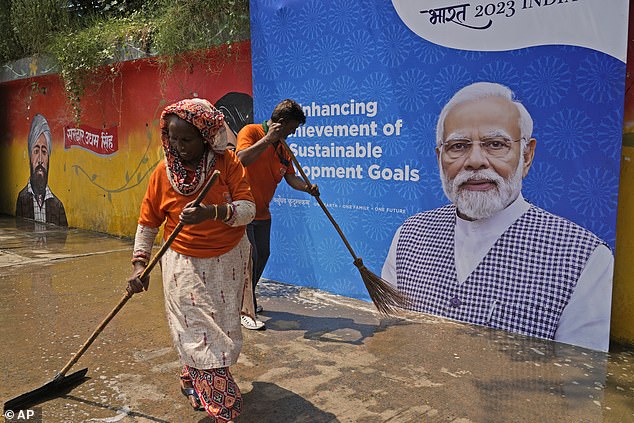
Clean image: Image of Indian Prime Minister Narendra Modi plastered all over New Delhi ahead of G20 meeting President Joe Biden is about to attend
There are eight Modi signs within sight of a convention center and a hotel where State Department officials have set up a room for US media.
‘Together solve the greatest challenges facing humanity’, reads a slogan.
“One world one sun,” says another, while a slogan “democratizing technology” alludes to the push to move supply chains in India to counterbalance China.
Sometimes digital billboards switch between multiple slogans, allowing people to see Modi at night — though traders are already complaining about a virtual lockdown of New Delhi from Friday, when Biden will arrive.
Others speak of “democratizing technology” and “deepening trust in our beloved planet,” though India has drawn criticism for continuing to import Russian oil during Ukraine’s brutal war.
There is a larger than life cutout of Modi near a central station. Even some of the humble tuk-tuks that cruise the streets on motorcycle engines carry ads in Hindi for cheap medical care – with Modi’s photo and the G20 logo on the back.
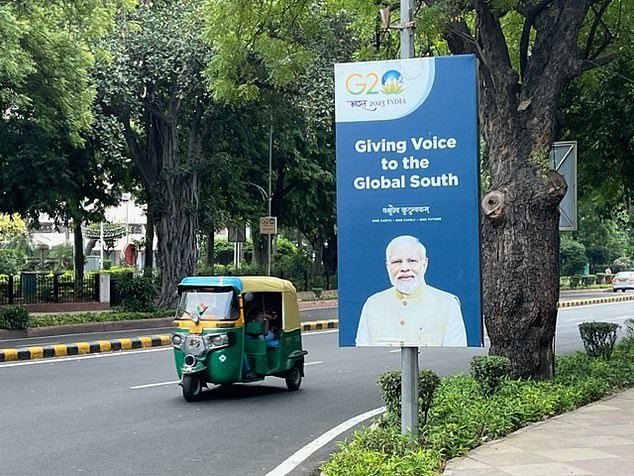
Modi uses the summit to position himself as leader of a ‘Global South’
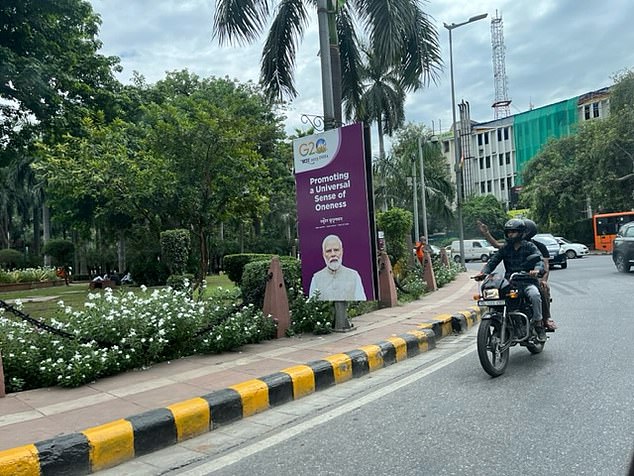
All for one! G20 signage also touts a ‘universal sense of unity’
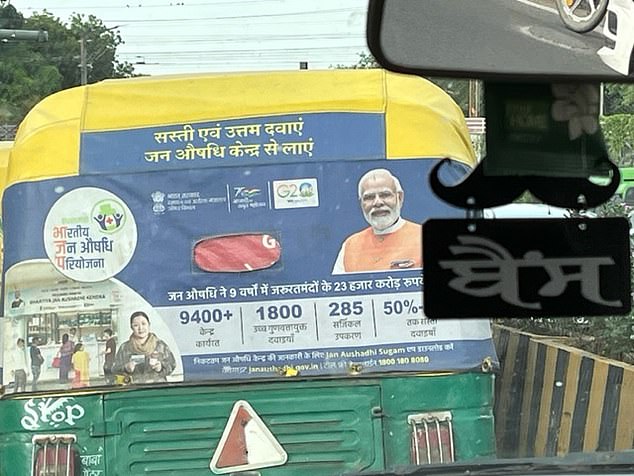
If Modi is not on a billboard or digital sign, he may be seen on the back of a tuk-tuk
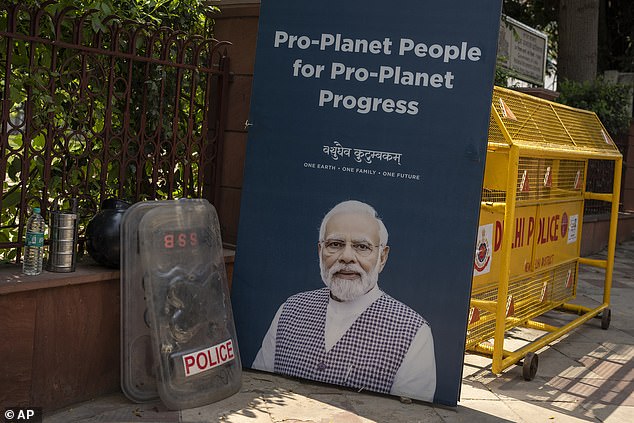
The signs have increased in number along with a greater police presence
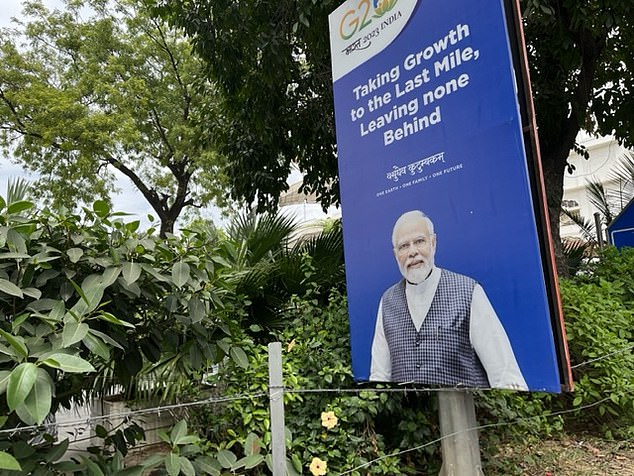
Modi is using the top to tout an equity agenda while placing India at the center of a tech boom and supply chain politics amid concerns about China.
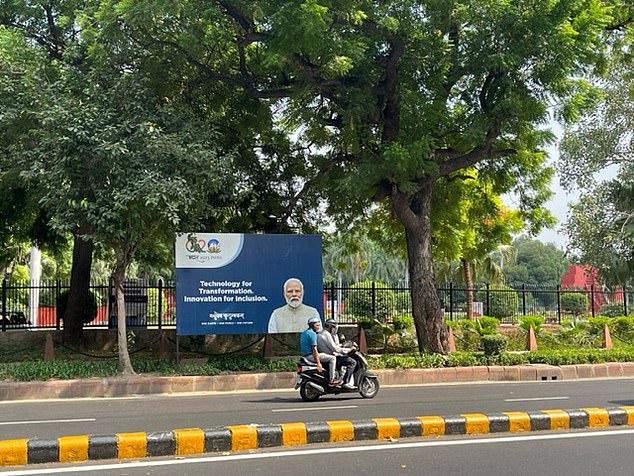
India is undergoing rapid growth and economic transformation
“In terms of domestic politics, it is clearly part of Modi’s call to make the Indian people think of him as the one who restored the country or raised it to a recognized status of great power,” said John Ciociari, director of the Weiser Diplomacy Center at the Ford School. University of Michigan International Policy Center at DailyMail.com.
“I understand they do a lot of marketing around the G20 to present this as an Indian achievement when in fact it’s just a rotating presidency,” he said.
All that Modi comes amid signs of domestic concern within India among US officials, including judicial action, press restrictions and bouts of religious violence, even as the country remains an important constitutional democracy critical to the US position in the region.
“It’s definitely tricky,” Ciociari said. “I think India’s recent past has been difficult for the United States in general. … And while I think there are certainly values that bind the US and India, India’s Democratic backsliding issues pose a challenge to Biden and to other US officials.”
He said there was a quiet acknowledgment that the relationship with the US is “too important to jeopardize by lecturing India much on democracy issues.”
It all comes at a summit where businesses in central areas have repainted, and gardeners and street cleaners have sprung into action to give the city (in wider Delhi, a population of 30 million) its best foot.
Modi is not the only one trying to get the best out of the top politically.
Biden’s presidential campaign announced Thursday that it is a new video with images of Biden’s risky visit to Ukraine – and explicitly linked to the G20 meeting. It is an attempt to contrast his multilateralism and global diplomacy with the policies of rival Donald Trump. (Trump and Modi shared a bond at their own ‘Howdy Modi’ rally in Texas).
“Ahead of the G20, Biden-Harris 2024 Announces New Ad Highlighting President Biden’s Leadership on the Global Stage,” read the headline of a press release announcing the new ad, touting Biden’s “quiet leadership” to the Russian President Vladimir Putin.
(TagsToTranslate)dailymail
